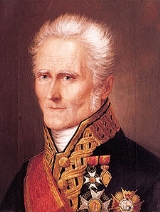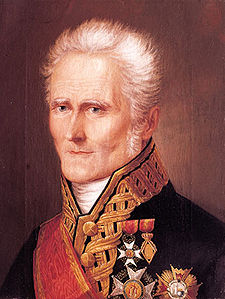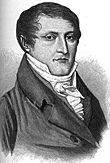
Battle of Ayohuma
Encyclopedia

Quechua languages
Quechua is a Native South American language family and dialect cluster spoken primarily in the Andes of South America, derived from an original common ancestor language, Proto-Quechua. It is the most widely spoken language family of the indigenous peoples of the Americas, with a total of probably...
) was an action fought on 14 November 1813, during the second Upper Peru
Upper Peru
Upper Peru was the region in the Viceroyalty of Peru, and after 1776, the Viceroyalty of the Río de la Plata, comprising the governorships of Potosí, La Paz, Cochabamba, Los Chiquitos, Moxos and Charcas...
Campaign of the Argentine War of Independence
Argentine War of Independence
The Argentine War of Independence was fought from 1810 to 1818 by Argentine patriotic forces under Manuel Belgrano, Juan José Castelli and José de San Martín against royalist forces loyal to the Spanish crown...
. The republican forces of the Army of the North
Army of the North
The Army of the North , contemporaneously called Army of Peru, was one of the armies deployed by the United Provinces of the Río de la Plata in the Spanish American wars of independence. Its objective was freeing the Argentine Northwest and the Upper Peru from the royalist troops of the Spanish...
, led by General Manuel Belgrano
Manuel Belgrano
Manuel José Joaquín del Corazón de Jesús Belgrano , usually referred to as Manuel Belgrano, was an Argentine economist, lawyer, politician, and military leader. He took part in the Argentine Wars of Independence and created the Flag of Argentina...
were defeated by the royalists, commanded by Joaquín de la Pezuela
Joaquín de la Pezuela
Joaquín de la Pezuela Griñán y Sánchez Muñoz de Velasco, 1st marquis of Viluma was a Spanish military officer and viceroy of Peru during the War of Independence.-Background:...
.
Background
After the rout of VilcapugioBattle of Vilcapugio
The Battle of Vilcapugio was an action fought on October 1, 1813 during the second Campaign of Upper Peru in the Argentine War of Independence, where the republican forces led by General Manuel Belgrano were defeated by a pro-Spanish royalist army, led by Joaquin de la Pezuela.The campaign was...
, Belgrano established his headquarters at Macha
Santiago de Macha
Santiago de Macha is a Bolivian city of the department of Potosí, in the province of Chayanta. The town had reached a population of nearly 10,000 people by 2008. Most of the young adult works abroad, and the village's marketplace opens only on Sunday...
. There he reorganized his army, obtaining help from Francisco Ocampo (then President of Charcas), and from the provinces of Upper Peru (Cochabamba
Cochabamba
Cochabamba is a city in central Bolivia, located in a valley bearing the same name in the Andes mountain range. It is the capital of the Cochabamba Department and is the fourth largest city in Bolivia with an urban population of 608,276 and a metropolitan population of more than 1,000,000 people...
, Santa Cruz de la Sierra
Santa Cruz de la Sierra
Santa Cruz de la Sierra, commonly known as Santa Cruz, is the capital of the Santa Cruz department in eastern Bolivia and the largest city in the country...
, and Chayanta
Chayanta
Chayanta is:*Chayanta Province, a province in the Potosí Department in Bolivia*Chayanta Municipality, a municipio in the Rafael Bustillo Province in Bolivia*Chayanta, Bolivia, a small town in the Chayanta Municipality in Bolivia...
). At the end of October 1813, the republican army included around 3,400 men, of which barely 1,000 were veterans. An important fraction of the republican army, under the command of General Díaz Vélez had remained isolated at Potosí
Potosí
Potosí is a city and the capital of the department of Potosí in Bolivia. It is one of the highest cities in the world by elevation at a nominal . and it was the location of the Spanish colonial mint, now the National Mint of Bolivia...
after Vilcapugio, but was able to reunite with Belgrano after a small action at Tambo Nuevo
Action of Tambo Nuevo
The Action of Tambo Nuevo, also known as Hazaña de los Tres Sargentos was a successful cavalry raid carried out between 23 and 25 October 1813, during the second Upper Peru campaign of the Argentine War of Independence, by a small detachment of Dragones of the Army of the North...
relieved them from the pressure of the royalist army.

In the meantime, just two leagues away from Toquirí, on 8 November, Belgrano had discussed his plans with his officials. The majority of them wanted to withdraw to Potosí, but the general convinced his officers to fight. That same night the army left Macha, reaching Ayohuma on the morning of the next day.
The battle
The armies that were about to face each other exhibited a significant disproportion. While the republican cavalryCavalry
Cavalry or horsemen were soldiers or warriors who fought mounted on horseback. Cavalry were historically the third oldest and the most mobile of the combat arms...
outnumbered the royalists' two-to-one, Pezuela had twice as much infantry and 18 pieces of artillery
Artillery
Originally applied to any group of infantry primarily armed with projectile weapons, artillery has over time become limited in meaning to refer only to those engines of war that operate by projection of munitions far beyond the range of effect of personal weapons...
, against only eight carried by Belgrano's troops.
At dawn of 14 November the royalists began their descent from their high position and by mid-morning they had deployed the bulk of their forces on the plain. Belgrano's troops were meanwhile attending Mass, even if aware of the enemy movements. An hour later, Pezuela had completed their maneuver, outflanking the republicans on their right. In the opinion of Lieutenant Gregorio Aráoz de Lamadrid
Gregorio Aráoz de Lamadrid
Comandante General Gregorio Aráoz de Lamadrid was an Argentine military leader and, briefly, governor of several provinces like Córdoba, Mendoza and his native province of Tucumán.Lamadrid fought beside General Belgrano and General San Martín during the Argentine War of Independence, as a prominent...
, one of Belgrano's best officers, this move proved decisive for the outcome of the battle. Then, Pezuela's artillery opened fire, blasting holes in the republicans ranks. In a hail of enemy fire, Belgrano ordered the advance of his infantry and cavalry toward the enemy right flank, but they could not overcame Pezuela's entrenchements. To make matters worse, the republican's lighter guns were no match for the royalists.
Belgrano was forced to retreat. By a trumpet call and waving the United Provinces
United Provinces of South America
The United Provinces of South America was the original name of the state that emerged from the May Revolution and the early developments of the Argentine War of Independence...
flag on the top of a hill, he managed to gather some 500 men, leaving around 200 dead, 200 injured, 500 prisoners and almost all his artillery on the battlefield. Belgrano's 500 survivors retreated to Potosí
Potosí
Potosí is a city and the capital of the department of Potosí in Bolivia. It is one of the highest cities in the world by elevation at a nominal . and it was the location of the Spanish colonial mint, now the National Mint of Bolivia...
, but the city had to be quickly evacuated due to the approaching royalists. Belgrano moved back to Tucumán
Tucumán
San Miguel de Tucumán is the capital of the Tucumán Province, located in northern Argentina at from Buenos Aires. It is the fifth biggest city of Argentina after Buenos Aires, Córdoba, Rosario and Mendoza, and it is also the most important city of Northern Argentina...
, where on 30 January 1814, he resigned the command of the Northern Army to General San Martín
José de San Martín
José Francisco de San Martín, known simply as Don José de San Martín , was an Argentine general and the prime leader of the southern part of South America's successful struggle for independence from Spain.Born in Yapeyú, Corrientes , he left his mother country at the...
. He would later write about the tactical superiority of the Spaniard officers as compared to his limited knowledge of warfare.
See also
- Battle of PequerequeBattle of PequerequeThe Battle of Pequereque was a clash which took place on 19 June 1813, during the second Upper Peru campaign of the Argentine War of Independence, between scouting forces of the United Provinces Army of the North and the royalist Army of Perú...
- Battle of VilcapugioBattle of VilcapugioThe Battle of Vilcapugio was an action fought on October 1, 1813 during the second Campaign of Upper Peru in the Argentine War of Independence, where the republican forces led by General Manuel Belgrano were defeated by a pro-Spanish royalist army, led by Joaquin de la Pezuela.The campaign was...
- Action of Tambo NuevoAction of Tambo NuevoThe Action of Tambo Nuevo, also known as Hazaña de los Tres Sargentos was a successful cavalry raid carried out between 23 and 25 October 1813, during the second Upper Peru campaign of the Argentine War of Independence, by a small detachment of Dragones of the Army of the North...
- Flag of MachaFlag of MachaThe flag of Macha is the name given to a pair of flags of Argentina found at a chapel near the village of Macha, north of Potosí, Bolivia. They are considered to be the first physical flags created by Manuel Belgrano, who hid them to prevent them from falling into enemy hands. They were discovered...
External links and references
- García Camba, Andrés (1846). Memorias para la Historia de las armas españolas en el Perú. Sociedad tipográfica de Hortelano y compañia, V. I.
- Goman, Adolfo Mario (2007). Enigmas sobre las primeras banderas argentinas. Cuatro Vientos. ISBN 9875647020
- The battles of Vilcapugio and Ayohuma.
- This article is based on the article :es:Batalla de Ayohuma in the Spanish Wikipedia, accessed on April 25, 2006.

